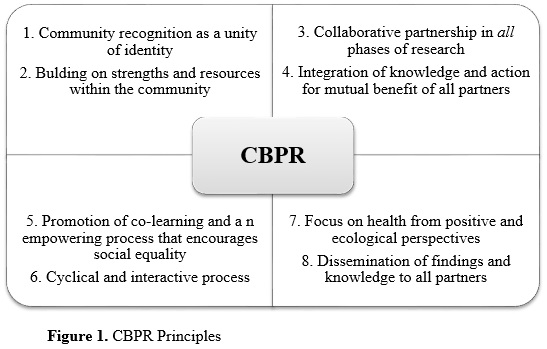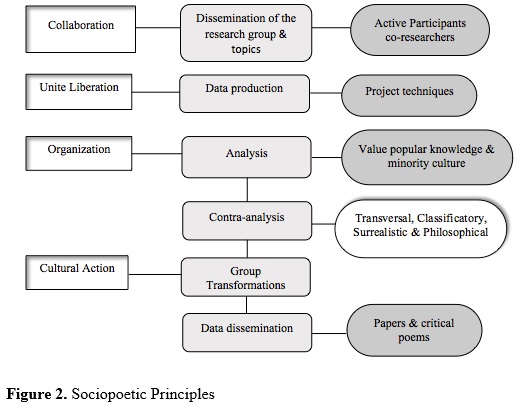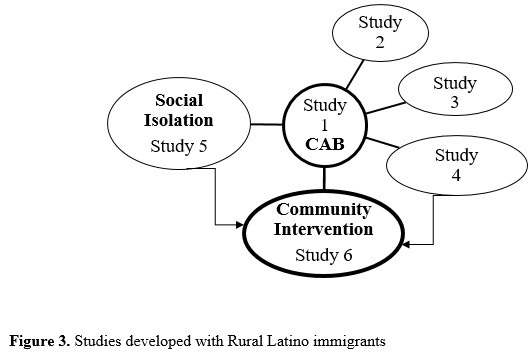
RESEARCH ARTICLES
Community-Based Participatory Research: working with and for rural Latinos in North Florida
Jeanne-Marie Rodrigues StacciariniI
IRN. PHD. College of Nursing, University of Florida Gainesville, FL, USA
DOI: http://dx.doi.org/10.12957/reuerj.2014.15779
ABSTRACT
This scientific report presents the research trajectory of using Community Based Participatory Research (CBPR) approach when working with low-income, underserved rural Latinos in North Florida, US. This overview focus on the studies developed with and for underserved rural Latinos and presents a brief description of the goals, main findings, and lessons learned from the six studies developed in the past seven years. All the studies have been focused on mental health promotion and its cultural relationship.
Keywords: Community based participatory reaserch; latin immigrating; mental health; cultural relationship.
INTRODUCTION
Scientific Research and Community-Engagement Research
As nurses and scientists it is fundamental to remember that the final outcomes of research should beto: 1) improve health programs, including private and public sectors, 2) influence health policies, 3) enhance health and wellbeing of diverse populations, 4) improve the quality of human lives, 5) reduce health disparities and 6) disseminate via scientific journals and other community forums.
Community Research Engagement (CEnR) is an approach that values relationships between communities, researchers, and research institutions. In fact, members are not considered research subjects; instead, they are partners. CEnR is grounded in the principles of community organization, which should be respected: know the community, build trust and relationships, partner with the community, respect community cultures and other factors in designing approaches, be flexible, release control to the community and make long-term commitments . Indeed, there are different levels of community engagement approaches, particularly considering the involvement, impact, trust and communication with the community, such as outreach, consultation, involvement, collaboration and shared leadership1.
There are various CEnR approaches, and they have all been instrumental in the process of understanding the complexities of human beings, of perceiving the subjective singularities, of valuing the (co) learning and preserving ethics in the production of scientific knowledge. Although the focus of this conference is the Socio-poetic, I will discuss a different community engagement approach, entitled Community Based Participatory Research (CBPR). Although the differences are not too simplistic, I will briefly present the main steps and concepts of socio-poetics and CBPR in the following graphics to differentiate the steps followed by both approaches: Sociopoetic and CBPR.


Using CBPR to approach mental health among underserved rural Latinos in Florida
Community-based participatory research (CBPR) has been developed over the last few decades as a transformative research paradigm that bridges the gap between science and practice through community engagement and social action, with the aim of increasing health equity2.
CBPR was selected as a research approach to study and interact with the community on mental health issues in Latino immigrants living in rural areas of Florida. This approach was chosen due to the alignment of principles of engagement within the CEnR continuum, which enabled us to develop culturally tailored mental health promotion interventions.CBPR has its origins in the studies of Kurt Lewin3 who proposed an action-based research program to address social disparities, and Paulo Freire 4,5, a Brazilian educator and activist, who raised oppressed peoples' awareness of social inequities through education and literacy engagement.
CBPR is characterized by three Rs: Respect for participants, Recognition of participants' contributions, and Return of findings to the community 6. CBPR pursues the following principles: . Active collaboration with community participants in all the research stages (from the development of research questions to dissemination,
. Knowledge integration for mutual benefits,
. Building capacity and
. Developing resources within the community1.
An overview of the all work performed with and for underserved rural Latinos will be presented with a brief description of the goal, main findings, and lessons learned from the six studies that have been developed in the past seven years (Figure 3). All the studies were performed with rural Latinos in North Florida, which are considered new destinations;that is, areas outside the traditional Latino gateways such as Miami, which is a large urban city in South Florida. These new destination areaslack the social support of traditional locations, often depriving Latino immigrants of significant social resources (7, 8).

Study 1 – Convene a Community Advisory Board (CAB).
This first CBPR study's purpose was to partner with the community in order to accomplish the following: develop relationships, inform the research process, recruit participants, and collect culturally relevant data about the mental health needs of Latinos in a rural community. In addition, the study aimed to interpret pilot data and design future studies with rural low-income immigrant Latinos in North Florida. In this initial step, I learned a great lesson from the CAB, which is that I had to follow requests from the community. In this case, despite my initial intentions to only include women in my studies, I included children as well at the request of the CAB. As a result, new research collaborators (a child psychologist and a bilingual educator) were invited to join the CAB. In this way, we were able to initiate the process of building the partnership for research—a process that was published in collaboration with community and academic members (9).
Study 2 – Mental Health Assessment
The purpose of this study was to assess depressive symptoms and stressors among a rural population of low-income Latino mothers/children and identify culturally appropriate approaches to treatment that would be supported by the community. Although the CBPR approach requires using aecological and healthy paradigm, we approached participants using the illness paradigm and assesseddepressive symptoms. In this stage, the greatest finding was about the "social isolation" phenomena identified through an open question in the demographic questionnaire. Social isolation may include complex psychosocial, linguistic, and cultural factors in rural Latinos. Thus, the following studies have been developed to understand more about social isolation in rural Latinos and identify steps towards developing a community-based intervention to minimize social isolation.
Study 3 – Faith Based Organizations (FBOs) Involvement
The purpose of this study was to describe FBO leaders' perceptions of the psychosocial contexts that affect mental wellbeing and potential approaches to mental health promotion in rural, Latino immigrants. FBO leaders were interviewed and their perceptions were categorized into three different levels: 1) Social Level: Health and Social Inequities and Immigration problems, 2)Community Level: Geographic Mobility 3)Individual Level: Lack of Linguistic and Cultural Knowledge & Building Capacity and Individual Personalities (10).In addition, we found that FBO leaders hope for community involvement and cultural unity, which emerged as independent categories. The findings of this study showed that FBO leaders are very knowledgeable about the psycho-social determinants of mental health among rural Latinos. They revealed a need to develop a system of social ties that expand beyond members of the church, which could enhance community cohesion. They also stated that researchers need to understand the social networks in the community in order to examine the factors affecting mental wellbeing. Finally, they noted that Faith-Based community interventions could be a safe and culturally-sensitive way of intervening with rural Latino immigrants who are at risk for mental health problems.
Studies 4 & 5-Social Isolation, Family Environment and Social Networks .
The main purpose of these studies was to describe family members' (e.g. Latino immigrant mothers, fathers, and adolescents) perceptions of their rural social environment and social isolation. In addition, we aimed to determine how these factors affect their families and theirmental well-being.Through our family interviews, we became interested in understanding how rurality and social networks act as social health determinants in rural Latinos. Thus, additional academic experts were sought to support the development of new knowledge: a medical geographer and an anthropologist with social network methodology expertise. Findings from these studies showed that social isolation is related to family members' mental wellbeing (11, 12) as well as spatial rural areas, particularly among women (13). Finally, linguistic isolation, racism and discrimination, and intense fear due to their undocumented status, are factors that may detrimentally affect rural Latinos' well-being.
The World Health Organization (14) has stated that all professions must contribute to the creation of more inclusive societies and the promotion of wellbeing through the reduction of social health determinants. Indeed, in this study, we learned the value of non-traditional, interdisciplinary collaboration and engagement in the effective promotion of mental health.
Study 6 – Community Intervention
Considering the complexities of the psychosocial factors related to mental wellbeing in rural Latinos, we are in the process of developing a Social Determinants of Mental Health (SDMH) intervention, which is church-based and culturally tailored to the community. For this study, the CAB members adapted a previously developed community intervention(terapiacomunitária)by a Brazilian social psychiatrist – Dr.Barreto. A recently completed pilot study (n=8 group sessions) of this intervention revealed additional concerns for mental within this community: intimate partner violence,passive attitudes, alcohol and drug abuse, and aversion to western treatment modalities, particularly for chronic illness (e.g. depression, diabetes and asthma). Thematic analysis of the verbal interactions during the SDMH group sessions demonstrated topics chiefly related to the lack of healthcare access, social isolation, and conflict within family members. Endorsed copings, during the group sessions, were related to finding emotional support in the family or church, as well as to the need of perseverance. Implemented cultural elements (e.g. language, church setting, and inclusion of traditional Latin songs) increase comfort among members and enhance positive, non-verbal behaviors. Overall the SDMH, which is a highly participatory intervention, allowed members to find common ground in regards to complex social-determinants of health and develop a strong sense of mutual trust. This SDMH will be further explored as a safe cultural intervention to reduce social isolation in rural Latino immigrants.
Reflections
The CBPR approach has facilitated an active and continuous collaboration between academics and community members, enabling the development of studies that help promote mental well-being with and for Latinos immigrants living in the rural areas of North Florida. Researchers and CAB members have been involved in all steps of the seven research studies. In addition, the researchers have been involved in several community events in order to be known and trusted by the target community. Recommended by the CAB, all the data collection has been performed by a bilingual lay-health community worker, who is a community-insider (promotora). She has been continually trained in all data collection and human subject protection protocol by the researchers. To be sensitive to participants needs, all data collection has been performed through individual meetingsat homeand on convenient days/times.
Several undergraduate and graduate students (N=20) have been involved in different projects as a way to learn basic as well as advanced research methods such as the application of CEnR in underserved communities. Because of their limited time and also to protect the communities from transitional individuals, students have limited engagement with the community members. They participate in CAB meetings, community events (e.g health fairs, public school events) and data analysis, but they are not involved in data collection and in visits to participants' houses. To meet dissemination requirements, findings from all studies have been presented at local, regional, national and international conferences, as well as published in a diverse array of interdisciplinary journals. Similarly, to meet community needs, research members have participated in several community events and have also presented findings in different forums, such as churches and public schools.
In our view as scientists, the CBPR approach has proved to be a transformative research opportunity to connect academics and communities as well as give underserved communities a genuine voice in research, and increase the likelihood of an intervention's success (2, 15).Furthermore, CBPR has allowed us to become collective and creative actors in the process of developing culturally sensitive interventions to promote mental wellbeing with and for underserved communities. Thus, this actively engaged process of reducing health disparities in an oppressed population has also transformed the researchers.
REFERENCES
1.Department of Health and Human Services (US). Principles of community engagement.Washington, DC2011. P.1-197. Report No.: 11-7782.
2.WALLERSTEIN Nina, DURAN Bonnie. Community-based participatory research contributions to intervention research: The intersection of science and practice to improve health equity. American Journal of Public Health. 2010;100(S1):S40-S6
3. LEWIN Kurt. Resolving social conflicts and field theory in social science. Washington, DC: American Psychological Association, 1997.
4. FREIRE Paulo. Pedagogy of the Oppressed Penguin: Harmonds, Worth, 1972.
5. FREIRE Paulo. Creating alternative research methods: Learning to do it by doing it. New Delhi: Society for Participatory Research in Asia, 1982.
6. WOLF Tom. The power of collaborative solutions: six principles and effective tools for building healthy communities. San Fransisco, CA: Jossey Bass, 2010..
7. SHIHADEH Edward, WINTERS Lisa. Church, place, and crime: Latinos and homicide in new destinations. Sociological Inquiry. 2010;80(4):628-49.
8. SHIHADEH Edward, BARRANCO Raymond. Latino immigration, economic deprivation, and violence: regional differences in the effect of linguistic isolation. Homicide Studies. 2010;14(3):336-55.
9. STACCIARINI Jeanne-Marie Rodrigues, WIENS Brenda, COADY Maria, SCHWAIT Anna, PÉREZ Awilda, LOCKE Barbara, et al. CBPR: Building partnerships with Latinos in rural area for a wellness approach to mental health. Issues in Mental Health Nursing. 2011;32:486-92.
10. STACCIARINI Jeanne-Marie Rodrigues, VACCA Raffaele, WIENS Brenda, LOE Emily, LAFLAM Melody, PEREZ Awilda. Community engaged research: involving FBOs to understand rural Latinos' mental health needs. Cultural Diversity and Ethnic Minority Psychology.2014;in review.
11. STACCIARINI Jeanne- Marie Rodrigues, SMITH Rebekah, WIENS Brenda, PÉREZ Awilda, LOCKE Barbara, LAFLAM Melody. I didn't ask to come to this country…I was a child: the mental health implications of growing up undocumented. Journal of Immigrant and Minority Health. 2014:1-6.
12. STACCIARINI Jeanne- Marie Rodrigues, SMITH Rebekah, GARVAN Cynthia, WIENS Brenda, Cottler, Linda.Rural Latinos' mental wellbeing: A mixed-methods pilot study of family, environment and social isolation factors. Community Mental Health Journal. 2014.
13. LIANG Mao, STACCIARINI Jeanne- Marie Rodrigues, SMITH Rebekah, WIENS Brenda. Activity space, rurality, and wellbeing of Latino immigrants: A GIS methodology. Health & Place. 2014; in review.
14. WORLD Health Organization.Closing the gap in a generation: health equity through action on the social determinants of health.In: Commission on Social Determinants of Health, 2008.15. MINKLER Meredith, WALLERSTEIN Nina. Community based participatory research for health: process to outcomes. 2nd ed. San Francisco, CA: Jossey Bass, 2008.